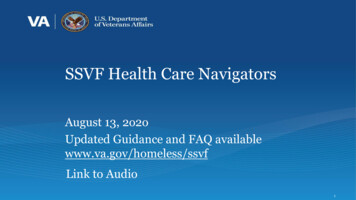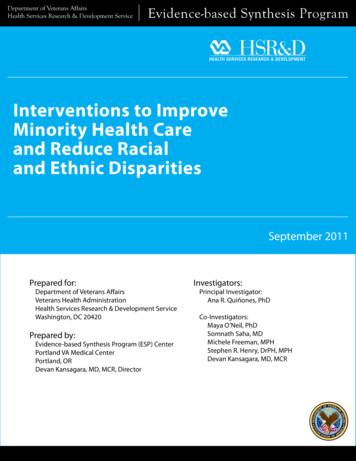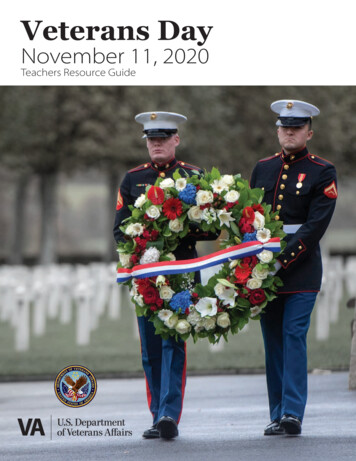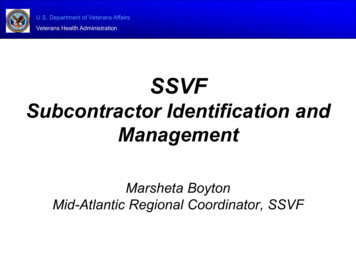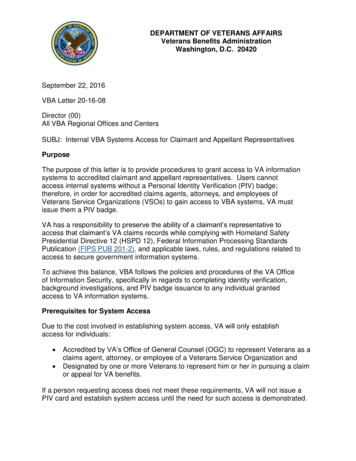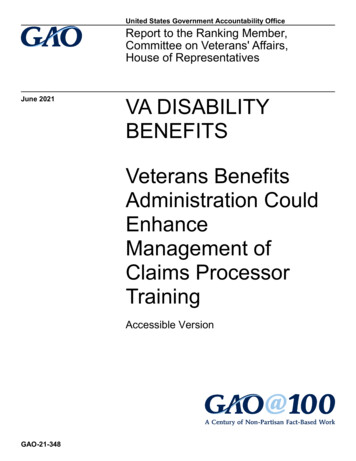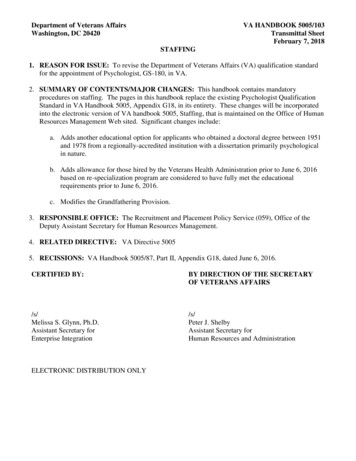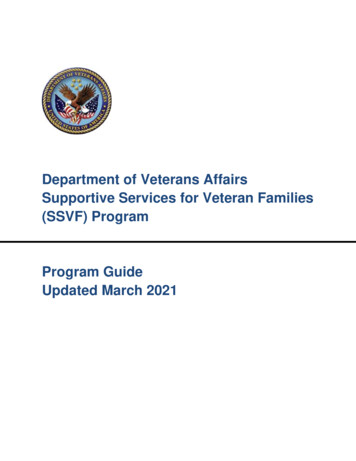
Transcription
Department of Veterans AffairsSupportive Services for Veteran Families(SSVF) ProgramProgram GuideUpdated March 2021
TABLE OF CONTENTSI. Introduction. 1A.Purpose of the Program Guide .1B.SSVF Program Description and Background .1C.Definitions .2II. Program Overview. 9A.Goal of the Supportive Services for Veteran Families Program .9B.Eligible Participants .9C.Supportive Services Provided.10D.Rapid Re-Housing Assistance .11E.Homelessness Prevention Assistance .11F.SSVF Coordination with Local Continuums of Care (CoCs) .12G.SSVF Coordination with VA Medical Centers .12H.VA Homeless Program Expectations for Coordinated Entry Participation .13I.Housing First .14J.Extremely Low Income .15K.Victims of Domestic Violence.15L.Returning Home .16M.Rapid Resolution .17N.Shallow Subsidy Initiative .17III. Renewal Process . 19A.Accreditation and Renewal Awards .19IV. Technical Assistance . 21A.Introduction .21B.Pre-Award Technical Assistance .21C.Post-Award Technical Assistance .21V. Participant Eligibility . 23A.SSVF Eligibility Requirements.23B.Determining Veteran Household Status Eligibility .24C.Determining Income Eligibility .26D.Determining Housing Status Eligibility.34E.Recertification of Eligibility .37F.Program Exits .38LAST UPDATED March 2021
G.Case File Documentation Requirements .39VI. Supportive Services . 43A.Introduction .43B.Outreach.43C.Case Management Services .48D.Assistance in Obtaining VA Benefits .51E.Assistance in Obtaining and Coordinating Other Public Benefits .52F.Other Supportive Services / Temporary Financial Assistance .60VII.Program Operations . 73A.Participant Agreements .73B.Participant Fees .73C.Participant Safety and Critical Incident Reports .73D.Habitability Standards .74E.Notification to Participants .75F.Conflict of Interest .75G.Confidentiality .75H.Veterans Rights .77I.Releasing Participants from Program .77J.Grievance and Appeals Policy and Procedures.78K.Subcontractor Management .78VIII.Fiscal Administration . 81A.Overview of HHS PMS Disbursement Platform .81B.Grant Draw Down Process .82C.Eligible Expenses .83D.Financial Close Outs .94E.Documentation Required .95F.Ineligible Activities .96G.Funding Sweeps .97IX. Training and Evaluation . 99A.SSVF Program Staff Training and Mentor Program.99B.Ensuring Adequate Fiscal and Operational Controls.99X. Reporting Requirements . 101A.Goals . 101LAST UPDATED March 2021
B.Reporting Process . 101C.Process of Program Remediation . 102XI. Program Resources . 105A.Program Development and SSVF Website . 106B.Program Operations . 106C.Sample Forms . 108D.Miscellaneous . 109XII.Exhibits .111Exhibit A: Income Inclusion and Exclusion Tables . 111Exhibit B: Documentation Standards . 117Exhibit C: Collaborative Delivery of GPD/HUD-VASH/HCHV/SSVF Services . 148Exhibit D: Guide for Pending Verification of Veteran Status (PVVS). 152Exhibit E: Homelessness Prevention Eligibility Screening Instructions . 153Exhibit F: SSVF Domestic Violence Guidance for HMIS Reporting . 156Exhibit G: The Rapid Re-housing Waiver . 158Exhibit H: Important Federal Policies . 160Exhibit I: History of Revisions Made to the Program Guide . 162XIII.Forms .171A.SSVF Pending Verification of Veteran Status Form . 171B.SSVF Literally Homeless Certification . 174C.SSVF Literally Homeless Self-Certification . 176D.SSVF Homelessness Prevention Screening Form . 177E.SSVF Income Verification . 185F.SSVF Self-Declaration of Income . 187G.SSVF Asset Income Calculation Worksheet . 189H.SSVF Income Calculation Worksheet . 191I.Staff Certification of Eligibility for SSVF Assistance . 193J.Staff Recertification of Eligibility for SSVF Continued Assistance . 194K.Domestic Violence Certification . 194L.SSVF Housing Stability Plan Template . 197M.Supportive Services Referrals Tracking Tool . 202N.Emergency Housing Assistance (EHA) Verification for Families. 204O.Emergency Housing Assistance (EHA) Verification for Single Veterans . 207LAST UPDATED March 2021
P.SSVF General Housing Stability Assistance (GHSA) Form . 212Q.Rent Reasonableness Checklist . 214R.Housing Habitability Standards Checklist . 215LAST UPDATED March 2021
SSVF Response to the COVID-19 Public Health CrisisThe Supportive Services for Veteran Families program is currently operatingunder more flexible regulations due to the COVID-19 Public Health Emergency.The Stafford Act allows SSVF to provide greater flexibility in the types andamounts of services available to Veteran households while the national publichealth emergency is in place. Details of related guidance can be found on theSSVF website and will be communicated via weekly program emails, webbroadcasts and SSVF Regional Coordinators. Guidance related to COVID-19 andthe Public Health Emergency supersede the relevant portions of this SSVFProgram Guide until further notice. SSVF Grantees will be instructed on how totransition back to normal program operations and guidelines as needed. Pleasereview both this Program Guide and the related guidance on SSVF’s Stafford Actflexibilities and submit questions to your Regional Coordinator or SSVF@va.gov.LAST UPDATED March 2021
DEPARTMENT OF VETERANS AFFAIRSSUPPORTIVE SERVICES FOR VETERAN FAMILIESPROGRAM GUIDESECTION I INTRODUCTIONA. Purpose of the Program GuideThe purpose of this Program Guide is to provide an overview of the Supportive Services forVeteran Families (SSVF) Program. This Program Guide has force for oversight, auditing,monitoring and program review purposes, and is to be used by applicants to the SSVF Program,SSVF grantees, Department of Veterans Affairs (VA) staff members, and other interested thirdparties involved in the SSVF Program. The Program Guide provides the following information:1. Program Overview2. Renewal Process3. Technical Assistance4. Participant Eligibility5. Supportive Services6. Program Operations7. Fiscal Administration8. Training and Evaluation9. Reporting Requirements10. Program ResourcesThe guidelines provided in this Program Guide are intended to be consistent with SSVFProgram regulations (38 CFR Part 62), and other applicable laws, Executive Orders, OMBCirculars, and VA regulations. In the event of a conflict between this Program Guide and VAregulations, applicable laws, OMB Circulars, or Executive Orders, such regulations, laws, OMBCirculars, or Executive Orders shall control. Guidelines should not be construed to supersede,rescind, or otherwise amend such laws, Executive Orders, OMB Circulars, and regulations.Grantees are responsible for ensuring compliance with the requirements of the SSVF Programregulations, the supportive services grant agreement, and other applicable laws and regulations.B. SSVF Program Description and BackgroundSection 604 of the Veterans’ Mental Health and Other Care Improvements Act of 2008, PublicLaw 110-387, authorized VA to develop the SSVF Program. Supportive services grants will beawarded to selected private non-profit organizations and consumer cooperatives that will assistvery low-income Veteran families residing in or transitioning to permanent housing. Granteeswill provide a range of supportive services to eligible Veteran families that are designed topromote housing stability.The statutory authority for the SSVF Program is found at 38 U.S.C. 2044. The implementingregulations are found at 38 CFR Part 62.LAST UPDATED March 2021Section I Page 1SECTION I INTRODUCTIONI. Introduction
DEPARTMENT OF VETERANS AFFAIRSSUPPORTIVE SERVICES FOR VETERAN FAMILIESPROGRAM GUIDESECTION I INTRODUCTIONPlease refer to 38 CFR 62.2 and 38 CFR 62.10 for definitions of terms used in the SSVFProgram. A summary of key definitions used within this Program Guide is provided below.Applicant: An eligible entity that submits an application for a supportive services grantannounced in a Notice of Fund Availability.Area or community: A political subdivision or contiguous political subdivisions (such as aprecinct, ward, borough, city, county, State, Congressional district or tribal reservation) with anidentifiable population of very low-income Veteran families.Consumer cooperative: See section 202 of the Housing Act of 1959 (12 U.S.C. 1701q).Continuum of Care (CoC): Continuum of Care and Continuum refer to the group that isorganized to carry out the responsibilities required under the Continuum of Care Programregulations, 24 CFR Part 578, composed of representatives of nonprofit homeless providers,victim service providers, faith-based organizations, governments, businesses, advocates, publichousing agencies, school districts, social service providers, mental health agencies, hospitals,universities, affordable housing developers, law enforcement, organizations that servehomeless and formerly homeless Veterans, and homeless and formerly homeless persons.These organizations consist of the relevant parties in the geographic area.Department of Defense (DD) Form 214: The Certificate of Release or Discharge from ActiveDuty issued by the Department of Defense to each Veteran, identifying the Veteran's conditionof discharge – honorable, general, other than honorable, dishonorable or bad conduct.Dependent: For SSVF reporting purposes only, dependents are defined as children under theage of 18 at project entry. This reflects an alignment with the Department of Housing and UrbanDevelopment’s (HUD) definition of “households with children and adults,” and can now betracked in and reported out of HMIS. (Note: a Veteran may identify adult dependents as part oftheir “household.” These adult dependents may be served as part of the Veteran family, but forSSVF and HMIS reporting purposes, would not be reported as a “dependent.”)Eligible child care provider: A provider of child care services for compensation, including aprovider of care for a school-age child during non-school hours, that: (1) is licensed, regulated,registered, or otherwise legally operating, under state and local law, and (2) satisfies the stateand local requirements, applicable to the child care services the provider provides.Eligible entity: (1) private non-profit organization, or (2) consumer cooperative.Emergency housing: Temporary housing provided under 38 CFR 62.34(f) that does not requirethe participant to sign a lease or occupancy agreement.LAST UPDATED December 2019Section I Page 2SECTION I INTRODUCTIONC. Definitions
PROGRAM GUIDESECTION I INTRODUCTIONEmergency Housing Assistance: The provision of up to 45 days of temporary housing for aVeteran family with dependents (up to 72 hours for a single Veteran) that does not require theparticipant to sign a lease or occupancy agreement. The cost cannot exceed the reasonablecommunity standard for such housing. Emergency housing is limited to short-term commercialresidences (private residences are not eligible for such funding) not already funded to provideon-demand emergency shelter (such as emergency congregate shelters).Extremely Low Income (ELI): An income category for a Veteran family whose annual income, inaccordance with 24 CFR 5.609, does not exceed 30 percent of the area median income.General Housing Stability Assistance: The provision of goods or payment of expenses notincluded in other sections but which are directly related to support a participant's housingstability, and are authorized under 38 CFR 62.34(e), which are not available through existingmainstream and community resources.Grant and Per Diem Program (GPD): See website for complete : An eligible entity that is awarded a supportive services grant.Health Care for Homeless Veterans (HCHV): See website for complete ss: The “homeless” definition has the meaning given by the U.S. Department of Housingand Urban Development (HUD) in 24 CFR ents/HEARTH ESGInterimRule&ConPlanConformingAmendments.pdf. For an at-a-glance reference meless, “Literally”: The “literally homeless” definition is a more narrow definition than“Homeless” defined above. It is this “literally homeless” definition that is a critical requirement toqualify Veterans for SSVF rapid re-housing (consistent with the Emergency Solutions Grantsprogram). This means every participant in SSVF rapid re-housing (category 2 and 3) is carefullyqualified within the parameters of “literally homeless.” Note that a Veteran who is residing inwhat is commonly referred to as a “doubled up” or a “couch surfing” situation in permanenthousing, or otherwise residing in permanent housing, would not fit the “literally homeless”definition below. Note that such persons would be considered category 1 and could qualify forhomelessness prevention. Further, persons fleeing or attempting to flee domestic violence areconsidered literally homeless and would be served as a rapid re-housing household.As per HUD 24 CFR 576.2, “literally homeless” is defined as:(1) An individual/family who lacks a fixed, regular, and adequate nighttime residence, meaning:LAST UPDATED December 2019Section I Page 3SECTION I INTRODUCTIONDEPARTMENT OF VETERANS AFFAIRSSUPPORTIVE SERVICES FOR VETERAN FAMILIES
i.SECTION I INTRODUCTIONii.iii.PROGRAM GUIDEAn individual or family with a primary nighttime residence that is a public orprivate place not designed for or ordinarily used as a regular sleepingaccommodation for human beings, including a car, park, abandoned building,bus or train station, airport, or camping ground;An individual or family living in a supervised publicly or privately operated shelterdesignated to provide temporary living arrangements (including congregateshelters, transitional housing, and hotels and motels paid for by charitableorganizations or by federal, State, or local government programs for low-incomeindividuals);An individual who is exiting an institution where s/he resided for 90 days or lessand who resided in an emergency shelter or place not meant for humanhabitation immediately before entering that institution.Homeless Management Information System (HMIS): The information system designated by theContinuum of Care to comply with the HUD's data collection, management, and reportingstandards and used to collect client-level data and data on the provision of housing and servicesto homeless individuals and families and persons at-risk of homelessness. HMIS is a valuableresource because of its capacity to integrate and un-duplicate data across projects in acommunity. Aggregate HMIS data can be used to understand the size, characteristics, andneeds of the homeless population at multiple levels: project, system, local, state, and national.Household: All persons as identified by the Veteran, who together present for services, andidentify themselves as being part of the same household.Housing and Urban Development-VA Supportive Housing (HUD-VASH): See website forcomplete details https://www.va.gov/homeless/hud-vash.asp.Notice of Fund Availability (NOFA): A NOFA is published in the Federal Register in accordancewith 38 CFR 62.40, which announces the availability of funds for supportive services grants.Occupying permanent housing: A very low-income Veteran family will be considered to beoccupying permanent housing if the very low-income Veteran family:(Category 1) Is residing in permanent housing and at risk of becoming literally homelessbut for grantee’s assistance;(Category 2) Is literally homeless, and at risk to remain in this situation but for grantee’sassistance, and scheduled to become a resident of permanent housing within 90 dayspending the location or development of housing suitable for permanent housing;or(Category 3) Is literally homeless after exiting permanent housing within the previous 90days to seek other housing that is responsive to the very low-income Veteran family’sneeds and preferences.Regarding above references to literally homeless: for specifics as to what circumstances do anddo not constitute literal homelessness, see the definition: Homeless, Literally.LAST UPDATED December 2019Section I Page 4SECTION I INTRODUCTIONDEPARTMENT OF VETERANS AFFAIRSSUPPORTIVE SERVICES FOR VETERAN FAMILIES
PROGRAM GUIDESECTION I INTRODUCTIONParticipant Household: A very low-income Veteran family occupying permanent housing who isreceiving supportive services from a grantee.Permanent Housing: Community-based housing without a designated length of stay where anindividual or family has a lease in accord with state and Federal law that is renewable andterminable only for cause. Examples of permanent housing include, but are not limited to: ahouse or apartment with a month-to-month or annual lease term, or home ownership. 1Private non-profit organization: Any of the following:(1) An incorporated private institution or foundation that:i.Has no part of the net earnings that inure to the benefit of any member, founder,contributor, or individual;ii.Has a governing board that is responsible for the operation of the supportiveservices provided under the SSVF Program; andiii.Is approved by VA as to financial responsibility.(2) A for-profit limited partnership, the sole general partner of which is an organization meetingthe requirements of paragraphs (1)(i), (ii) and (iii) of this definition.(3) A corporation wholly owned and controlled by an organization meeting the requirements ofparagraphs (1)(i), (ii), and (iii) of this definition.(4) A tribally designated housing entity (as defined in section 4 of the Native American HousingAssistance and Self-Determination Act of 1996 (25 U.S.C. 4103)).Rapid Re-housing: An intervention designed to help individuals and families quickly exithomelessness and transition to permanent housing. Rapid re-housing assistance is offeredwithout grantee required preconditions such as employment, income, absence of criminalrecord, or sobriety. Support services are tailored to the unique circumstances of each individualparticipant household to facilitate a rapid transition to permanent housing. The three corecomponents of rapid re-housing are identifying housing, providing rent and move-in financialassistance, and offering case management and related services. While a rapid re-housingprogram must have all three core components, it is not required that a single entity provides allthree services nor that a household utilize them all.State: Any of the several States of the United States, the District of Columbia, theCommonwealth of Puerto Rico, any territory or possession of the United States, or any agencyor instrumentality of a State exclusive of local governments. The term does not include anypublic or Indian housing agency under the United States Housing Act of 1937.Subcontractor: Any third-party contractor, of any tier, working directly for an eligible entity.1 Note:Transition in Place (TIP) programs where the very low-income Veteran family maintains an independent leasewith a landlord and maintains lease rights to the unit throughout TIP program enrollment and conclusion withoutexception are considered permanent housing.LAST UPDATED December 2019Section I Page 5SECTION I INTRODUCTIONDEPARTMENT OF VETERANS AFFAIRSSUPPORTIVE SERVICES FOR VETERAN FAMILIES
PROGRAM GUIDESECTION I INTRODUCTIONSupportive services: Any of the following provided to address the needs of a participant:(1) Outreach services as specified under 38 CFR 62.30.(2) Case management services as specified under 38 CFR 62.31.(3) Assisting participants in obtaining VA benefits as specified under 38 CFR 62.32.(4) Assisting participants in obtaining and coordinating other public benefits asspecified under 38 CFR 62.33.(5) Other services as specified under 38 CFR 62.34.Supportive services grant: A grant awarded under the SSVF Program.Supportive services grant agreement: The agreement executed between VA and a grantee asspecified under 38 CFR 62.50.Suspension: An action by VA that temporarily withdraws VA funding under a supportive servicesgrant, pending corrective action by the grantee or pending a decision to terminate the supportiveservices grant by VA. Suspension of a supportive services grant is a separate action fromsuspension under VA regulations implementing Executive Orders 12549 and 12689,“Debarment and Suspension.”VA: Department of Veterans AffairsVBA: Veterans Benefits AdministrationVery low-income Veteran family: A Veteran family whose annual income, as determined inaccordance with 24 CFR 5.609, does not exceed 50 percent of the median income for an areaor community (current income limits can be found .Veteran: Veteran: A person who served in the active military, naval, or air service, regardless oflength of service, and who was discharged or released there from. Veteran excludes a personwho received a dishonorable discharge from the Armed Forces or was discharged or dismissedfrom the Armed Forces by reason of the sentence of a general court-martial. The length ofservice restrictions under 38 U.S.C. 5303A do not apply.Veteran family: A Veteran who is a single person or a family in which the head of household, orthe spouse of the head of household
The Stafford Act allows SSVF to provide greater flexibility in the types and amounts of services available to Veteran households while the national public health emergency is in place. Details of related guidance can be found on the SSVF website and will be communicated vi a weekly program emails, web broadcasts and SSVF Regional Coordinators.
